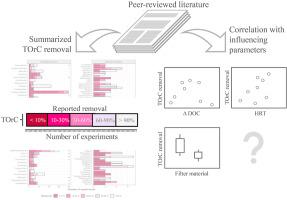Chemosphere ( IF 8.1 ) Pub Date : 2021-01-24 , DOI: 10.1016/j.chemosphere.2021.129774 Josefine Filter , Veronika Zhiteneva , Carsten Vick , Aki Sebastian Ruhl , Martin Jekel , Uwe Hübner , Jörg E. Drewes

|
The removal of trace organic chemicals (TOrCs) from treated wastewater and impacted surface water through managed aquifer recharge (MAR) has been extensively studied under a variety of water quality and operating conditions and at various experimental scales. The primary mechanism thought to dictate removal over the long term is biodegradation by microorganisms present in the system. This review of removal percentages observed in biologically active filtration systems reported in the peer-reviewed literature may serve as the basis to identify future indicators for persistence, as well as variable and efficient removal in MAR systems. A noticeable variation in reported removal percentages (standard deviation above 30%) was observed for 24 of the 49 most commonly studied TOrCs. Such variations suggest a rather inconsistent capacity of biologically active filter systems to remove these TOrCs. Therefore, operational parameters such as the change in dissolved organic carbon (ΔDOC) during treatment, hydraulic retention time (HRT), filter material, and redox conditions were correlated to the associated TOrC removal percentages to determine whether a data-based relationship could be elucidated. Interestingly, 11 out of the 24 compounds demonstrated increased removal with increasing ΔDOC concentrations. Furthermore, 10 compounds exhibited a positive correlation with HRT. Based on the evaluated data, a minimum HRT of 0.5–1 day is recommended for removal of most compounds.
中文翻译:

天然处理系统中痕量有机化学物质的变化衰减-关键影响因素综述
在各种水质和操作条件下以及在各种实验规模下,已经通过可管理的含水层补给(MAR)从处理过的废水和受影响的地表水中去除痕量有机化学物质(TOrC)的方法得到了广泛的研究。被认为长期决定清除的主要机理是系统中存在的微生物的生物降解作用。对同行评审文献中报道的在生物活性过滤系统中观察到的去除百分率的审查,可以作为确定未来持久性指标以及MAR系统中可变和有效去除率的基础。在49个最常研究的TOrC中,有24个在报告的去除率上有显着变化(标准偏差超过30%)。这种变化表明,生物活性过滤系统去除这些TOrC的能力相当不稳定。因此,将操作参数(例如处理过程中的溶解有机碳的变化(ΔDOC),水力停留时间(HRT),过滤材料和氧化还原条件)与相关的TOrC去除百分比相关联,以确定是否可以阐明基于数据的关系。有趣的是,在24种化合物中,有11种表现出随着DOC浓度的增加而去除的增加。此外,有10种化合物与HRT呈正相关。根据评估的数据,建议去除大多数化合物的最小HRT为0.5–1天。将水力停留时间(HRT),过滤材料和氧化还原条件与相关的TOrC去除百分比相关联,以确定是否可以阐明基于数据的关系。有趣的是,在24种化合物中,有11种表现出随着DOC浓度的增加而去除的增加。此外,有10种化合物与HRT呈正相关。根据评估的数据,建议去除大多数化合物的最小HRT为0.5–1天。将水力停留时间(HRT),过滤材料和氧化还原条件与相关的TOrC去除百分比相关联,以确定是否可以阐明基于数据的关系。有趣的是,在24种化合物中,有11种表现出随着DOC浓度的增加而去除的增加。此外,有10种化合物与HRT呈正相关。根据评估的数据,建议去除大多数化合物的最小HRT为0.5–1天。











































 京公网安备 11010802027423号
京公网安备 11010802027423号